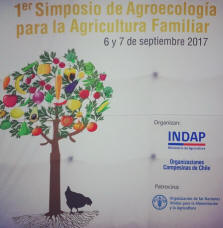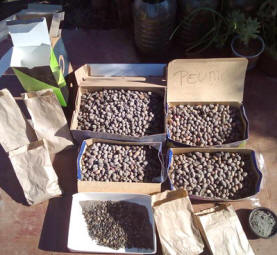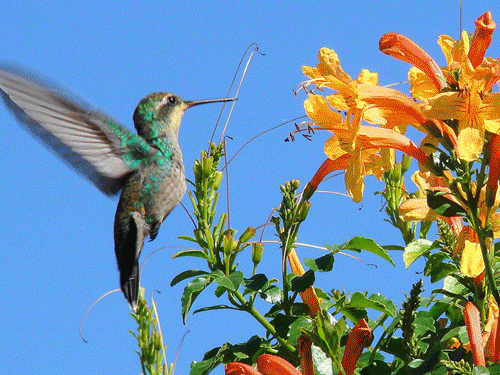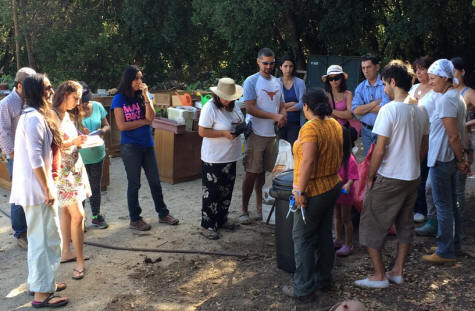|
Award for Development of Homa Ecological Agriculture in First Symposium for Family Agriculture
|
|||
|
|||
Organic Certification for ‘Satsang’ Homa Farm, Curacaví, Chile
|
Satsang is part of the Organization of Organic Producers of Curacaví |
||
|
Activation of a Homa Resonance Point in ‘Casa Picaflores’ Farm, Naguabo, Rio Blanco, Puerto Rico
|
|
Homa Organic Farming Workshop in ‘Satsang’ Farm, Curacavi, Chile
|
“Wake Up Before It’s Too Late:” New UN Report Calls for Dramatic Shift Toward Natural Agriculture
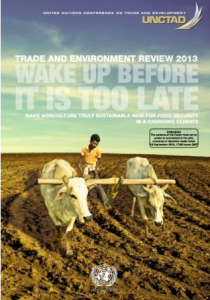 |
Even as the United States government continues to push for the use of more chemically-intensive and corporate-dominated farming methods such as GMOs and monoculture-based crops, the United Nations is once against sounding the alarm about the urgent need to return to (and develop) a more sustainable, natural and organic system.
That was the key point of a new publication from the UN Commission on Trade and Development (UNCTAD) titled “Trade and Environment Review 2013: Wake Up Before It’s Too Late,” which included contributions from more than 60 experts around the world. Continue reading ““Wake Up Before It’s Too Late:” New UN Report Calls for Dramatic Shift Toward Natural Agriculture” |
What’s Wrong With Our Food System?
Birke Baehr – 11 year old Organic Food Activist (video)
“What’s Wrong With Our Food System? And How Can We Make A Difference?”
Recently, Birke was a speaker at a TED Conference. The annual TED conferences, in Long Beach/Palm Springs and Oxford, bring together the world’s most fascinating thinkers and doers, who are challenged to give the talk of their lives (in 18 minutes). TED is a small nonprofit devoted to Ideas Worth Spreading. It started out (in 1984) as a conference bringing together people from three worlds: Technology, Entertainment, Design. Since then its scope has become ever broader. Along with two annual conferences — the TED Conference in Long Beach and Palm Springs each spring, and the TEDGlobal conference in Oxford UK each summer — TED includes the award-winning TEDTalks video site, the Open Translation Project and Open TV Project, the inspiring TED Fellows and TEDx programs, and the annual TED Prize.
Summer Festival at Homa Hof, Heiligenberg, Germany
On 23rd of July 2011, a summer festival was held at the Homa Farm called ‘Homa Hof’ at Heiligenberg (southern Germany), which was well received.
This Homa farm was founded in 1988 and is run by over 60 honorary members. Beside morning and evening Agnihotra, other disciplines are practiced regularly as recommended by Shree Vasant (5 o’clock morning mantra, Vyahruti Homas at 10,12,15,18, and 21 and Om Tryambakam Homa is maintained at least 4 hours daily). In addition, on many occasions the Tryambakam Homa is practiced for 24 hours or more. In an area of 20 hectares, 8 ha are used for agriculture, which are managed with great success applying Homa Therapy techniques. (Please also see Homa Hof testimony)
Every 3-4 weeks free information sessions are offered.
Approximately 70 visitors came from near and far for the summer meeting and at various points of the farm different activities were offered. These were:
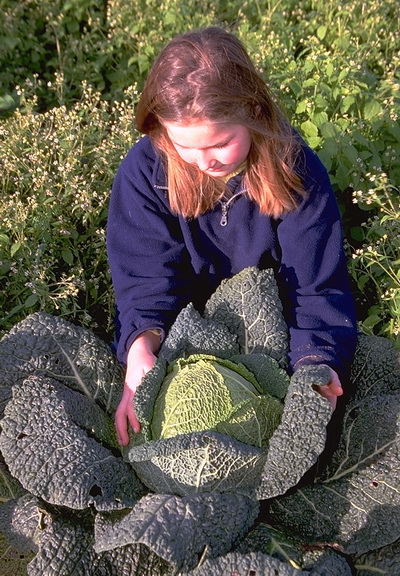
Continue reading “Summer Festival at Homa Hof, Heiligenberg, Germany”
Report from Tingo Maria, Peru, 1999
Translation from original Spanish document signed and sealed by the Ministry of the Presidency – INADE (National Institute of Development) Republic of Peru, Special project Alto Huallaga
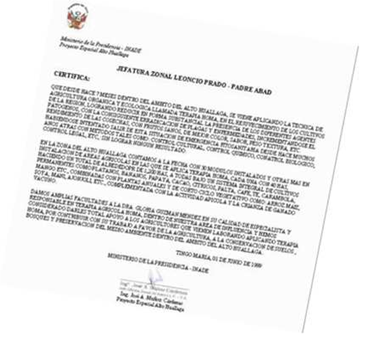
The Headquarters of the Zone Leoncio Prado-Padre Abad Certifies:
That since 7 months ago, in the area of Alto Huallaga, an Organic and Ecological technique called HOMA THERAPY, is being applied in the rejuvenation of the crops of the region, achieving to substantially reduce the existence of different pathogenic agents. As a consequence, plagues and diseases were eradicated, the yield of the harvest was increased, the fruit grew healthy, with better color, taste, weight, texture, etc.
Since many years, efforts have been made to overcome the critical situation regarding plant health, with methods such as: cultural control, chemical control, biological control, legal control, etc., without having achieved any success.
In the zone of Alto Huallaga to date we have established 30 modules and more are being installed in agricultural areas in which HOMA THERAPY is being applied, each one with 40 hectares. This makes a total of about 1,200 hectares; all of them are under an integrated system of perennial crops such as plantain, bananas, papaya, cocoa, citrus, avocados, coffee, tea, star fruit, mango, etc. These are combined with annual crops of a short vegetative cycle such as rice, corn, soya bean, nuts, sesame, etc., and complemented with apiculture and cattle rearing.
We give full support to Dr. Gloria Guzman Mendez in her capacity as expert and the person in charge of AGRICULTURAL HOMA THERAPY in our area of influence and we have considered to give total support to the farmers who have been working in the application of HOMA THERAPY because with their work, they are making a contribution in favor of agriculture, of the conservation of soils, forests and the preservation of the environment in the area of Alto Huallaga.
Tingo Maria, May 17th, 1999
MINISTRY OF THE PRESIDENCY-INADE
Special Project Alto Huallaga
(Signature)
_______________________
Engineer Jose A. Muñoz Cardenas
Chief, Support Office of the Zone L.P.-P.A.
Organic Foods vs. Conventional Food
It’s a sad state of affairs when more than three billion people around the world suffer from malnourishment – including in the U.S. – and yet most ‘improvements’ to increase food production is simply making our food less nourishing, rather than more so.
But more and more people are getting wise to this problem and are inciting change through their shopping habits and pocketbooks.
A 2007 study published in the American Journal of Agricultural Economics found that shoppers were willing to pay more for locally grown food, and those shopping at farmers’ markets were willing to spend the most for food grown close to home.
Small local farms are cropping up as a result, and many of them use organic, sustainable farming practices even though they may not have been certified as such.
The top reasons people cite for wanting organic, locally-grown food?
• Better food quality
• Better taste
• Freshness
And no wonder, considering the fact that studies, such as the one above, is finding that conventionally grown produce simply isn’t what it used to be.
Many “health” experts continue to state that there is little difference between organic and conventionally raised produce, but if they review this and other evidence, they will likely have to change their tune.
Organic Foods – a Far More Nutritious Choice
The simplest way back toward health is to focus on whole, organic foods, grown or raised as nature intended. Meaning, it’s grown using sustainable farming practices, and without the use of chemical additives, pesticides and fertilizers.
Food grown in healthier soil, with natural fertilizers and no chemicals, simply has to be more nutritious. It is common knowledge — though knowledge that is greatly suppressed in the United States.
A 2003 study in the Journal of Agricultural Food Chemistry, for example, found that organic foods are better for fighting cancer. And in 2005, scientists found that, compared to rats that ate conventional diets, organically fed rats experienced various health benefits. Rats that ate organic or minimally fertilized diets had:
Improved immune system status
Better sleeping habits
Less weight and were slimmer than rats fed other diets
Higher vitamin E content in their blood (for organically fed rats)
But perhaps one of the best studies out there on the benefits of organic versus conventionally-grown foods is the 2007 QualityLowInputFood Project — a $25-million study into organic food — the largest of its kind to date.
The researchers grew fruit and vegetables, and raised cattle, on adjacent organic and non-organic sites, and discovered that:
Organic fruit and vegetables contain up to 40 percent more antioxidants
Organic produce had higher levels of beneficial minerals like iron and zinc
Milk from organic herds contained up to 90 percent more antioxidants
The results were so impressive they stated that eating organic foods can even help to increase the nutrient intake of people who don’t eat the recommended five servings of fruits and vegetables a day.
As illustrated in the two charts below, this four-year, European-Union-funded study also found marked differences between dry matter, mineral, vitamin, protein, and amino acid concentrations between organic and conventional crops.
And, Don’t Forget About the Chemical Toxins!
In addition to simply being depleted of many essential nutrients — for all the reasons mentioned in the article above — conventionally grown food is also typically tainted with a multitude of chemical residues, including chemical fertilizers, insecticides, and herbicides.
These chemical concoctions can cause a wide variety of health problems, including:
Neurotoxicity
Disruption of your endocrine system
Cancer
Immune system suppression
Male infertility and miscarriages in women
Traditional, Local Farming on the Rise
Unfortunately, whereas organic foods were once truly raised naturally, on small farms with great integrity, big business has now stepped in and tainted many of the principles upon which the organic label was founded. You are, in fact, being ripped off by much of the organic food you are buying, so buyers beware…
However, increasing numbers of people are now reverting back to the ways of our ancestors, choosing to purchase food directly from local farmers – who generally apply organic farming practices — and cooking it using slow, traditional methods.
Proof of this trend can be seen in the rise of small farms. After declining for more than a century, the number of U.S. small farms has increased 20 percent in the past six years.
But there is still a long way to go. Organic food represents less than 2 percent of the food economy, and local food makes up well under 1 percent. There is some debate on the issue of which is better: organic or locally-grown. Ideally you’ll want both.
But keep in mind that even if your local farmer is not certified as organic, by speaking with them and establishing a rapport you will truly know how your food is raised and grown. Many small farmers grow their crops according to organic standards, yet are unable to afford the federal certification progress to legally call them so.
But in the end, it’s not really the certification itself – which big food manufacturers can afford – that matters, but whether or not your food has been grown in a manner that is compatible with nature and will sustain your good health.
Oil Palm Cultivation with Homa Technology in Peru
|
MINISTRY DEPARTMENT OF AGRICULTURE That within the areas of the Ucayali Region, where Oil Palm crops are cultivated, in the summer season, the production of bunches of fresh fruits decreases considerably. In other areas, the Oil Palm harvests are suspended during the summer season, due to the low production of clusters, further worsening the serious situation that the palm growers of our region have been experiencing, due to the low yield in the harvests, due to the presence of pests and diseases. Added to this are acidic soils with little fertility and with the presence of weeds. Continue reading “Oil Palm Cultivation with Homa Technology in Peru” |


